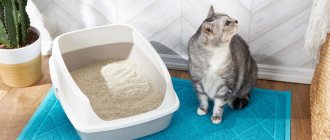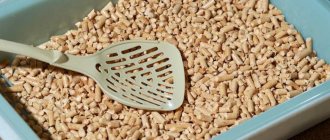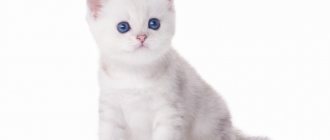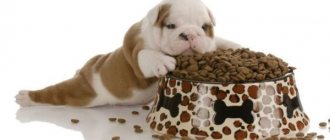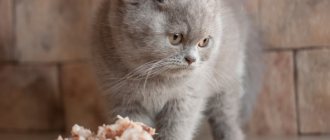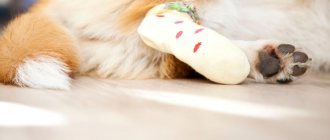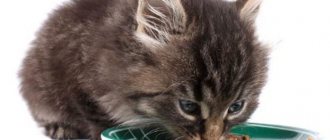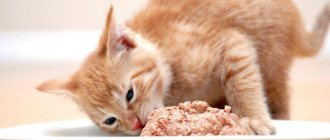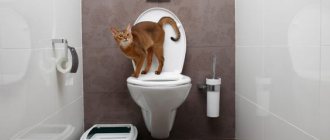Today, many cat breeders are faced with difficult choices in terms of nutrition for their pet. You can, of course, take the path of least resistance and accustom kittens to dry food from a young age. Thus, the owners make life easier only for themselves: they do not need to spend extra time preparing special food for their four-legged pet, it is much easier to clean the place where the pet eats food, because nothing gets spilled or gets dirty. The owner only needs to pour dry food into a bowl - and the cat’s lunch is ready! But do not forget that all food, especially dry food, is very addictive. If they are used too often, and even more so constantly, even an adult cat, not to mention a small kitten, can develop a number of diseases.
Dangerous consequences of eating ready-made food
No matter how beautifully dry food manufacturers advertise their products, most of them try not to voice the fact that the constant consumption of industrial food by animals leads to disastrous consequences. And among them, veterinarians most often note the following:
- vitamin deficiency (not all feeds contain exactly the vitamins and microelements that are indicated on the packaging);
- dysbacteriosis (for preservation, carcinogens and various chemicals are added that cause indigestion and metabolic disorders);
- urolithiasis (neutered cats are especially susceptible to this disease, although cats are not immune from kidney disease);
- allergic reactions (since the basis of dry food is legumes, animals experience flatulence and bloating; due to the dyes included in the composition, problems with hair and skin can occur - itching, sores, baldness).
The list of unpleasant consequences can be continued endlessly, but this is already enough to conclude that it is more correct and healthier to feed kittens and adult cats with regular homemade food.
Homemade food for kittens and adult animals
When buying a kitten from a breeder, almost everyone is interested in the baby’s usual diet. The grown-up animal can already cope quite well without mother’s milk and is accustomed to eating from a common bowl. In the first days, try not to disrupt the baby’s usual diet, because moving to a new unfamiliar place will be a big shock for him. But when the cat is completely comfortable, you can switch him to homemade food.
The transition to new food should be done gradually. First, add a little homemade food to the usual food, and then completely replace the entire feeding. Young kittens usually respond painlessly to changes in diet, which cannot be said about adult pets.
When switching from dry food to healthy food, an older cat may demonstratively turn away from the bowl and organize a “boycott”. This does not mean at all that in the future the pet will not eat anything except industrial food. The fact is that he simply experiences a “dependence” on dry food.
Dry food contains large quantities of monosodium glutamate, which not only gives the product an unnatural, sharp taste, but also irritates the taste buds. That is why a cat, accustomed to rich aromas and tastes, does not want to eat natural products that are not endowed with such qualities. The animal will most likely resist the introduction of a new diet, meow and ask for its favorite “snacks”; it is quite possible that it will refuse food and thereby attract pity. Getting your cat to eat healthy food will not be easy, so you should be patient and stick to your plan. Moreover, natural products introduced into a cat’s diet will only bring benefits to the pet.
Healthy Pet Diet
Before you start feeding your cat homemade food, you should familiarize yourself with information about products that can and should be included in your pet’s diet.
- Meat base. Meat is best given to animals raw. To avoid the appearance of worms, you should first freeze raw, lean meat pieces and feed your cat after they have been completely thawed. Young kittens can scald raw meat with boiling water before feeding. The best foods to feed are chicken, beef, turkey, and horse meat. It is better not to give lamb and pork to cats.
- Fish. Inhabitants of rivers and seas must be included in a cat’s diet only after heat treatment. Fish can be fed to cats no more than three times a week.
- Vegetable component. The cat's diet must be filled with vegetables. It is best to include boiled carrots and pumpkin in your food. Boiled and baked onions will also enrich your furry pet’s diet and replenish potassium deficiency. But you should avoid potatoes because of the starch they contain and the high glycemic index.
- Cereals. It is preferable to use oats and pearl barley for feeding cats. Many cats do not eat buckwheat porridge, but semolina itself is not recommended by veterinarians (it contains a lot of carbohydrates, which can cause obesity).
- Milk and dairy products. Fermented milk products with minimal fat content are healthy and are indicated for inclusion in the diet of cats. Any cat will eat natural yoghurts, bifidokefir, and low-fat cottage cheese with pleasure. But you should avoid sour cream, cream and milk. These foods can cause both intestinal upset and constipation.
When preparing food for feeding cats, you do not need to add spices and salt. Animals should not interrupt the natural taste of food with various seasonings.
Where to start on the road to dry food?
As practice shows, about 35% of kittens independently switch to dry food, provided they have free access to clean drinking water, because there is no liquid in the food! This means that there are no special problems.
However, the remaining 65% of kittens flatly refuse the proposed menu. In this case, you should slowly accustom your pet to the desired diet according to a certain scheme. If you follow simple rules, the transition process takes 15 days.
Begin to introduce dry granules gradually, with a few pieces added to the food:
- children's meat pates are mixed with several food granules;
- dry food is diluted with baby milk formula;
- The kitten is delayed from serving the portion for 1-1.5 hours, and then first offered dry food, and only then the usual food.
This start will allow the kitten to become familiar with new food and appreciate its benefits. The main thing here is not to shout or force the kitten, otherwise instead of quick training you will get big problems.
First feeding of newborn kittens
From birth until three to four weeks, kittens receive all the nutrients their bodies need along with colostrum and mother's milk. But the needs of an intensively growing body change and from about four weeks you can gradually introduce new foods into the diet.
Kittens are accustomed to solid food, which is given in small portions, ready-made canned food, and special mixtures. They are introduced into the diet gradually. During this period, prepared foods are not the main diet for babies. They are given rather to familiarize the animal with new food, to smoothly prepare the growing organism for the finished diet.
But you need to understand that hard granules of ready-made food will be difficult for a kitten to chew, so complementary feeding starts with canned food. Only after about a month can you switch the kitten to dry food. Thus, you can feed kittens dry food only when they are 2 months old. The process of completely transferring kittens from mother's milk to a ready-made diet will take several months.
Important! As soon as the kitten begins to show interest in natural food, new foods can be introduced into its diet. If you organize the nutrition system correctly, do everything step by step, stick to the regime, the transition from mother's milk to natural food or ready-made food will be almost imperceptible for the kitten.
Many well-known brands and brands that specialize in producing products for pets include food for kittens of various age groups.
When choosing ready-made food, take into account the breed characteristics of your pet, the individual, physiological characteristics of the body, and activity level. Give preference to products from well-known brands of the “premium”, “super-premium”, “extra” class categories, since they have a balanced composition and do not contain harmful dyes, flavors, or other substances. The composition includes natural ingredients, vitamins, essential amino acids, and minerals.
Veterinarians and experienced breeders recommend using products from the following brands for kittens:
- Royal Canin.
- Hills.
- Eagle Pack.
- About the Plan.
- Akana.
General rules
General rules that help teach a cat to eat dry food must be taken into account without fail, but not strictly followed, since in each case the individual characteristics of the cat must be taken into account.
© shutterstock
The main recommendations for transferring a cat to dry food include the following::
- a gradual increase in the amount of dry food in the diet every day for a week - if the cat has a weak stomach, then the increase in the volume of dry food should occur very slowly and increasing portions is allowed only every 3-4 days;
- a sharp change in food, if the cat immediately eagerly eats dry food - the pet is rarely ready to switch to dry food after eating natural food, but when she eats it with appetite and does not suffer from diarrhea or constipation, it would be optimal to immediately try to change the diet, as this will reduce period of stress for the body;
- constant availability for the pet of a large amount of clean and fresh water - since dry food always causes extreme thirst in the animal, it must be possible to quench it immediately. If the cat is thirsty and there is no water, he will not get used to dry food;
- transferring all cats in the house to dry food - this is possible if all the animals are in normal health and can eat this way. When at least one cat eats natural food, it will not be possible to train others to dry it.
When you decide to feed your cat dry food, you should immediately place two bowls in front of it - one with natural food, and the second with dry food. If she chooses dry food herself, preferring them to natural ones, then psychological stress for the animal due to the disappearance of the usual food can be completely avoided.
Optimal age to change a kitten's diet
As soon as they are born, kittens find the strength to crawl to their mother’s nipple to take their first sips of colostrum. At birth, kittens' intestines are sterile, meaning they cannot process any food. Colostrum is rich in beneficial bacteria that help newborn kittens process their mother's milk.
From the moment of birth until approximately one month of age, kittens feed only on their mother's milk. As babies grow up, they begin to smell. At about one month of age, kittens begin to be attracted to the smells of adult food. As soon as the babies begin to leave the nest, the breeder introduces supplementary food into their diet.
Depending on the preferences of the breeder, the kittens begin to be supplemented with:
- Boiled minced meat, low-fat dairy products.
- Canned industrial food for kittens.
After supplementary feeding is introduced, kittens begin to grow more actively and quickly expand their diet. All this time, the baby’s digestive system adapts to digesting new food. With the correct, gradual introduction of supplementary feeding, no negative effects on the gastrointestinal tract are observed. If the gastrointestinal tract is hypersensitive, kittens may develop diarrhea.
Note! Many purebred kittens have a hereditary predisposition to sensitivity of the digestive system. If you decide to buy a British or Scots dog, be sure to consult with the breeder about the diet, possible allergies and gastrointestinal problems.
Digestion of a kitten at 2–3 months
At 2 months, kittens begin to actively explore the world and try it out. In addition to the function of determining the edibility of an object, chewing and licking everything around has an additional function. Bacteria constantly enter the kitten’s body, and the immune system fights them.
Little kittens receive immunity from their mother, or rather, they receive antibodies from her milk. As soon as the kittens start supplementing, they begin to develop their own immunity. By the way, the mother’s immunity will protect babies up to 3 months of age.
At 3 months, kittens receive their first worm prevention and vaccination. At this stage, the already established functioning of the gastrointestinal tract may fail. Vaccination involves introducing a weakened virus into the body, followed by the development of immunity to it. After vaccinations, the kitten may experience a slight increase in base temperature and gastrointestinal upset.
Digestion of a kitten at 4 months
At 3–4 months, kittens usually move to a new home. Theoretically, the baby’s body will be ready for a change in diet, however, it is important to consider that the functioning of all body systems is greatly affected by stress. Weaning, moving to a new home, and other stressful situations can affect the functioning of the gastrointestinal tract.
To reduce risks, new owners are not recommended to change the kitten’s diet and feeding schedule during the adaptation period. As practice shows, three-month-old kittens fully adapt to their new housing within 7–10 days. Before buying a kitten, be sure to consult with the breeder, find out what supplementary food the kittens received and stock up on the necessary products for the next two weeks.
Advice: if the kittens received a natural diet, consult the breeder about the choice of food. Perhaps your baby has allergies, diabetes, or other hereditary factors that you need to know about.
How to move forward to dehydrated food?
If a start has been made and the kitten has begun to eat dry food, it is worth putting dry food granules in a bowl between feedings. The main thing is, do not forget to add clean water to the drinking bowl in time, because the cat’s body will have to spend a lot of water to soften the food granules.
Standard scheme for accustoming to a new diet in 15 days: on the first day, you add about 1/10 of the dry granules to the food you were used to at that time, gradually increasing the proportion of dry food to 100% on the 15th day. If at any stage the process freezes, reduce the concentration to the previous one and switch to a smoother pace.
How to switch a cat to a balanced diet in a week?
In order for the period of food change to be as comfortable as possible, you need to set aside at least a week for it, and sometimes it may take more time. First of all, you need to purchase good aromatic food so as not to alienate the animal from a new type of food. Below is an approximate diagram of changing the nutritional diet:
- On the first day, you should take a small amount of granulated food and soak it in water. After the granules are soaked, you need to add them to a bowl with your usual food. In this way, the cat gets acquainted with the new taste and aroma that is in its bowl.
- In the next three days you need to do the same, only gradually increasing the number of granules. In addition, the food can not only be soaked in water, but also in meat and fish broth, milk, and liquid porridge.
- By the fourth day, the pet gradually adapts to the new taste, and dry food, rather than soaked food, can be added to his bowl. After the animal eats this, you can give it its usual food to reward it. If he refuses to eat balanced stones, then dry food will need to be mixed with natural food for further adaptation.
- On the fifth day, you should gradually increase the amount of dry granules and reduce the dosage of “natural”. At the same time, one circumstance remains important - clean and fresh water is always available. Since the transition from one diet to another is usually accompanied by an increased feeling of thirst.
- And only after a week can only dry granules be poured into the cat’s bowl.
During the first week of switching to granulated food, you need to carefully monitor the kitten’s stool; if problems with constipation or diarrhea begin, then you should consult a veterinarian, maybe this type of food does not suit him.
How to find out if the food is suitable
At the stage of accustoming a cat to new food, the owner should be alert to the following alarming symptoms in the pet:
- stool disorder;
- decreased appetite;
- lethargy;
- discharge from the eyes, which may indicate an allergy;
- aggressiveness.
It is possible to assess whether the food really suits your pet well only after a few weeks. During this period, you need to pay attention to the condition of the coat and skin, the amount of urine and the quality of the stool. If your cat goes to the litter box to urinate less times a day than usual, you need to give your pet more water (if you can’t encourage your cat to drink more, you can alternatively add a canned product from the same manufacturer to the dry diet).
Good quality dry food contains all the substances necessary for your pet, so additional feeding is not required during the transition to dry food. Particular attention should be paid to super premium and holistic foods that are balanced in minerals and vitamins.
Super premium and holistic food supplies the animal with all the substances, vitamins and minerals necessary for proper development
Train your cat to eat dry food within a week
If your pet has previously eaten only natural food and canned meat, dry kibble may seem inedible to him. Therefore, there is no need to start with radical measures. Try offering food unobtrusively, presenting it as a treat. For example, handgive during play, in a situation where the cat usually receives a reward. This preparation will help your pet form positive associations with the smell and texture of the new product. Next, we proceed directly to training.
On the first day, serve your cat his usual food with the addition of dry granules in a 4:1 ratio. If he perceives this normally, after a couple of days the share of “drying” can be increased, while simultaneously reducing the amount of other food. And so on until he completely switches to a new type of food. The process may take a week or two, but the animal will not experience stress or digestive problems.
Typical mistakes in introducing dry food
For some reason, many kitten owners are sure that there is no need to accustom their pet, and that the kitten itself must guess that the food offered is nothing more than its breakfast, lunch or dinner. Most likely, such owners are guided by the principle “if you want, you can eat whatever.”
However, this is a bad strategy. Firstly, it is ineffective, and secondly, a kitten with its sensitive digestion and weak immunity will easily develop serious health problems, which the owner will have to solve.
That's why:
- You should never punish a kitten for refusing dry food;
- It is prohibited to force an animal to dry food;
- You cannot speed up the process at will.
Pros and cons
Of course, there is no consensus on whether cats can be given dry food or not. And veterinarians don't always agree. But it is worth saying that dry food has a balanced composition, is complete, and therefore can be used for feeding kittens.
Attention! Especially for the little ones, ingredients that are as safe and easy to digest as possible are added so that there are no problems with digesting food.
According to other veterinarians, cats should not be fed dry food because they are carnivores by nature. In addition, feeds existing on the market do not always meet the content requirements. But in fact, good, and therefore expensive, food is an excellent solution, since it consists of natural ingredients that are safe for babies.
Especially for the little ones, ingredients that are as safe and easily digestible as possible are added.
Modern pet products include a variety of foods with different flavors and contents. But if you consult with a veterinarian and monitor the condition of your kitten, you can easily select dry food and accustom your pet to it as competently as possible without compromising its health and activity. The main thing is to train correctly, following the advice of professionals!
Reasons for refusing new food
When switching to dry food, the kitten may become stubborn and hungry, but not touch the food offered. Let's find out why this happens:
- He may simply not understand that in front of him is food, and not pebbles or strange filling.
- The pellets may be too large for his jaws. Choose food designed specifically for kittens. If necessary, you can crush it or grind it in a blender.
- The kitten may simply not like the smell or taste of the product. Buy small packages and try giving your baby food with different ingredients.
A separate question is why an adult cat does not eat expensive dry food. An animal may refuse super premium or holistic food because it was previously fed economy options containing flavorings and taste enhancers. In this case, it will be more difficult to accustom your pet to healthy food, but it still needs to be done for the sake of its health.
How to behave when switching a kitten to a new food?
Everyone knows that cats are wayward animals. Therefore, it will not be possible to get what you want from them by force. You need to be able to negotiate with them. How to accustom a kitten to dry food without it causing him harm? The following rules must be adhered to:
- You should not scold your pet, because he may also be stressed, and this will worsen the situation, so the animal may refuse new food.
- You should not give dry food right away, as haste can be harmful. It is advisable to start by mixing it into natural food.
- There is no need to succumb to pitiful glances and meows, since cats understand that the owner can be manipulated. Then the process will drag on.
- When you leave for work at first, you should not leave only granules in the bowl.
This is all the information on how to accustom a kitten to dry food. The helpful tips above will help make this process painless for your pet. After this, you can feed the animal with commercial dry food, and this will not cause him any inconvenience.
Age
When is the best time to switch a kitten to dry food? It is advisable not to do this until the age of 1-1.5 months, at which time mother’s milk should enter his body. Only after reaching this age can you be accustomed to a diet that will be constant. It is advisable to start with meat baby food, as kittens love it. Over time, you need to add dry food to it. Kittens readily eat soggy granules. Gradually you need to increase the amount of food. By 2-2.5 months the animal will be accustomed to dry food.
Which food to choose?
The correct choice of dry food determines whether the baby will get used to the new diet and how the change in menu will affect his health. Veterinarians advise buying food that is produced specifically for kittens. Moreover, it will be easier to accustom cats to a new menu with them.
Almost any brand's product line includes specialized dry food for kittens. It is important to choose a super premium or holistic food that meets the needs of the carnivorous animals that are cats.
Monitor your pet's reaction
When introducing a kitten to dry food, carefully monitor what is happening. If the baby is cheerful and active, gains weight well, and his gastrointestinal tract works like a clock, then the diet has been chosen correctly.
If your pet has loose stools or constipation, allergy symptoms (itching, rash, hair loss), you need to pause the transition to a new diet and seek advice from a veterinarian.
Sources:
https://murkosha.ru/nashi-stati/soderzhanie-i-ukhod/kak-priuchit-kotenka-k-sukhomu-kormu
https://www.acana.ru/kak-priuchit-kotyonka-k-suhomu-kormu
Reasons for switching to a different type of nutrition
Before switching your cat to dry food, you need to understand the rationality of this decision. Now you will find out why dry food is better than natural food.
Many pet owners prefer natural food, considering this option more nutritious and healthy. But not every person is ready to spend a lot of time calculating the percentage of meat products, cereals, vegetables and fruits in the animal’s diet. A pet's diet should be balanced, only then will the animal be healthy and active.
Premium and super premium dry food is the ideal solution for every pet owner, including representatives of the cat family. Today, pet stores and veterinary pharmacies offer a wide range of balanced industrial nutrition for cats, taking into account the age, gender and physiological characteristics of certain breeds. When choosing dry food, you should carefully study the component composition of the product, and also pay attention to the amount of fiber, proteins, fats, carbohydrates, vitamin and mineral supplements.
About the choice and quality of food
Most owners decide to switch their pet to dry food for a trivial reason - there is no time to cook for the pet separately. The reason, frankly, is valid, since high-quality dry food is many times better than food from the table. Moreover, feeding from the table is dangerous for the development of allergies, obesity, diabetes and other ailments with equally frightening names.
If you decide to switch your pet to dry food, it is important to consider in advance not only the pros, but also the disadvantages that you may encounter.
Let us immediately note that dry food has more advantages:
- Easy to buy, easy to store and no cooking required.
- Easy to dose.
- The food is already balanced and fortified, no additives or dietary adjustments are needed.
- It has an attractive smell and is usually eaten with pleasure by cats.
There are also disadvantages:
- The food may be fake, it is not immediately obvious, but damage to health is guaranteed.
- Food purchased by weight may not be fresh, mixed with expired food, or of poor quality.
- Constantly feeding only dry food is fraught with rapid damage to teeth. At the same time, when diluting the diet with canned food, drying has a preventive effect.
- Good food costs “good”.
When deciding to switch your cat to dry food, you must understand that it comes in different qualities. Cheap, advertised economy-class food is not suitable for everyday feeding of an animal.
Products become cheaper due to:
- Replacing animal proteins with plant proteins.
- Using soy or legumes as a base.
- The use of flavor enhancers and flavorings to develop addiction in animals.
- The use of preservatives, most often salts, to extend shelf life.
- Using dyes and additives to create an attractive appearance and smell.
It’s paradoxical, but against the backdrop of such strict savings on the composition of feed, manufacturers invest huge amounts of money in its advertising. Economy class food can only be considered as a temporary measure, for example, during a move or other circumstances that do not allow you to feed your cat something else.
Premium and super-premium food is suitable for everyday feeding of healthy animals. The premium line is considered everyday and assumes ideal animal health. Only the super-premium segment is suitable for feeding sterilized cats or animals with health problems.
Note! In some cases, for example, with diabetes or atopic allergies, the animal can be fed only holistic food.
Holistic class is considered the highest quality; no preservatives should be used in its production... which affects the price.
The main problems when switching to dry food
Oddly enough, when owners switch cats from natural food to cheap dry food, no problems arise. Economy segment food is generously flavored with flavor enhancers, so the cat eats it with pleasure. Moreover, in a short time the cat develops an addiction, so she refuses to eat anything other than the food she loves.
Premium (and higher) food segments do not have a strong odor or too strong taste, so a cat may prefer natural food to them. It is important to understand that if you have chosen high-quality dry food as a replacement, problems with changing the diet depend on your pet’s habits.
It is also important to take into account the fact that in order to chew granules, the cat must have healthy teeth. If you see your pet trying to eat dry food but swallowing it whole or experiencing discomfort, contact your veterinarian. In adult cats, silent diseases of the oral cavity often occur.
Note! A cat may refuse to chew kibble if it has gum problems, such as periodontal disease.
The importance of water when feeding dry food
Usually a dry diet is supplemented with fresh water, and this is really very important, because with this type of food the animal begins to drink much more. Therefore, there should always be enough fresh water next to the food. At first, you can even place several bowls around the house, especially in places where the cat is most often. To encourage your pet to drink more, water is poured into large containers (basins, buckets) or drinking fountains are used (many cats prefer to quench their thirst from these).
How to increase a cat's appetite?
There are several ways to increase your four-legged pet’s appetite:
- Cook your favorite dishes. If your cat loves meat, when preparing food, the emphasis should be on this product. You can try to interest animals whose favorite treat is an egg with a boiled yolk.
- Offer the cat a new dish that the little tailed little one has not yet eaten. Perhaps the cat's curiosity will rise and she will try the treat.
- Prepare liquid, flavorful food. Smell plays an important role in the formation of appetite.
- Soak dry granules if the cat eats ready-made food, or offer him tasty pieces in sauce or jelly.
- Place some catnip in a bowl.
- Buy grass for cats at a pet store. You should not waste time germinating grains yourself, as the problem requires an urgent solution.
- Give your pet vitamins approved by your veterinarian to stimulate appetite, containing seaweed, mint, yeast and other components.
How to make a kitten eat?
One of the following methods will help you encourage your kitten to eat:
- Bring your finger, on which a little food is applied, to the baby's face. Perhaps this way it will be possible to awaken in him the desire to eat.
- Holding the baby by the head, slowly introduce liquid food into his cheek from a small syringe, pipette or baby bottle.
- Pour slightly warmed milk into a bowl, bring the baby to it and wet his nose with it.
Foods cats love most
There are foods that most cats like:
- meat;
- fish;
- fermented milk products (kefir, cottage cheese, yogurt, cheese, fermented baked milk);
- eggs.
These foods are best for whetting your pet's appetite. To restore your animal's interest in food, you can try giving him a boiled yolk, a small piece of low-fat cheese, a ball of minced meat, and a little sour cream.
Share with friends!
Why switch to a dry diet?
Dry food has a number of important advantages:
- Balanced composition. High-quality products contain the optimal amount of animal protein, fiber, minerals, vitamins and amino acids. With a natural diet, choosing the right proportions is quite difficult.
- You can choose food that is suitable for the animal’s age or condition: many manufacturers have special diets for kittens, adult and elderly pets, for allergy sufferers, etc. There are veterinary lines for sick animals. It is recommended to switch sterilized pets to diet food with a minimum of magnesium and phosphorus - this helps to avoid obesity and urolithiasis. It is even more difficult to provide your pet with such a highly specialized diet on your own.
- Save time. Menu planning, purchasing and preparing products for natural food take a lot of time.
- Unlike natural and wet food, dry food does not spoil for a long time even in the heat. If the animal is not prone to overeating, such food can be left in excess in the bowl: the cat can have lunch while the owners are at work. Dry food can be used to refill all types of automatic feeders.
- Dry food hardly stains your hands and things, so you can keep a few granules with you - this is important in cases where you have to tame a wild street kitten.
Please note that all of the above benefits apply to truly high-quality products, that is, premium, super-premium and holistic food. Economy class products are made from low-quality raw materials, contain carcinogens and other harmful substances, and therefore can cause enormous damage to the health of the animal.
Transfer to medicated feed should be carried out only after discussion with a specialist.


